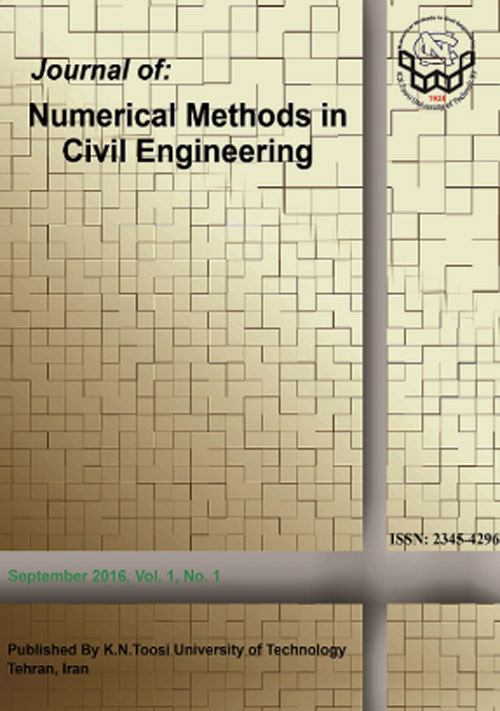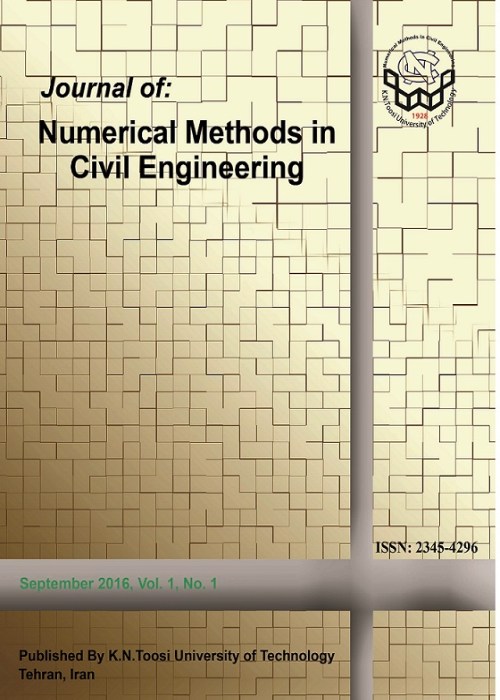فهرست مطالب

Journal of Numerical Methods in Civil Engineering
Volume:2 Issue: 4, Jun 2018
- تاریخ انتشار: 1397/11/15
- تعداد عناوین: 6
-
-
Pages 1-9
Production and prediction of land-use/land cover changes (LULCC) map are among the significant issues regarding input of many environmental and hydrological models. Among various introduced methods, similarity-weighted instance-based machine learning algorithm (SimWeight) and Markov-chain with lower complexity and proper performnce are frequently used. The main aim of this study is utilizing SimWeight along with Markov chain to predict land-use map of Lavasanat basin located in north-east of Tehran for the year 2018. In this regrad, eight driver variables and two land-use maps of the sudy area which were created from two Landsat-5 TM image sensor for the years 2000 and 2011 were considered as input. To evaluate the result of SimWeight, Receiver Operating Characteristic was used. The Land-use map of year 2018 was predicted using the proposed method. To evaluate this map, a land-use map of 2018 was produced using classification of a Landsat-8 OLI image. The results of model and value of area under curve (AUC) for transition potential map was about 0.78, which indicated good performance. Furthermore, the comparison of two produced and predicted land-use maps of 2018 shows great similarity. Generally, the results indicated the proper performance of the propsed method to predict LULCC.
Keywords: Land-use change, SimWeight, Markov chain, Lavasanat -
Pages 10-19
A proper composition of stiffness and ductility parameters is required to obtain a resistant and economic structure. Accordingly, Chevron Knee Braced Frame (CKBF) seems appropriate due to its proper seismic performance. The advantage of this system comes to having the capability of rapid and cheap replacement of chevron knee elements after an earthquake occurs. In this research, response modification factor and over-strength factor are determined for CKBF in two statuses of chevron V bracing and chevron inverted V bracing. The effect of using Easy-Going Steel (EGS) on the knee is also studied in the 3,6,9 and 12 story frames. In addition, the methods used for this purpose are nonlinear static analysis, linear dynamic analysis and Incremental Dynamic Analysis (IDA). IDAs have been conducted on 17 records of important universal earthquakes using Opensees software.
Keywords: Chevron knee bracing, Response modification factor, Over-strength factor, Incremental dynamic analysis, Easy going steel -
Pages 20-26
Dynamic analysis of shear building structures (SBS) is achieved using fast wavelet transform (FWT). The loads are considered as acceleration of earthquake record. for the analysis, A time history dynamic analysis is carried out. A fast wavelet transform is used by which the number of points in the earthquake record is reduced by filter bank. In the filter bank method, the low-pass and high-pass filters are used for the decomposition of earthquake record into two parts. One part contains the low frequency, and the other part contains the high frequency of the record. The low frequency is the most important part; therefore, this part of the record is used for dynamic analysis of structures. A shear building structure is analyzed and the results are compared with exact dynamic analysis (EDA) and fast Fourier transform method. It is concluded that the best choice for approximation record was the second and third stage of decomposition. Also, overall time for dynamic analysis was reduced using Fwt.
Keywords: Dynamic analysis Filter banksFast wavelet transformsEarthquake record -
Pages 27-38
Generally, side orifices are installed on side walls of the main channels for regulating and controlling water. In this study, a novel hybrid model was developed in order to estimate discharge coefficient of circular and rectangular side orifices. The model was obtained using combination of ANFIS, Genetic Algorithm and Particle Swarm Optimization. Then, 6 different models were defined for each ANFIS and hybrid models. Also, Monte Carlo Simulations (MCs) were used to survey abilities of the numerical models. Additionally, k-fold cross validation (k=5) was employed to validate the numerical models. Next, using sensitivity analysis, the superior model and the most effective parameters were identified. The best model simulated the discharge coefficient using all input variables this with high accuracy. For instance, the correlation coefficient and scatter index for the model were computed 0.856 and 0.027, respectively. Furthermore, the dimensionless parameter “the ratio of height of the side orifice to the side orifice diameter (W/D) was identified as the most effective variable input.
Keywords: Side orifice, Open channel, ANFIS, Genetic Algorithm, Particle Swarm -
Pages 39-47
One of the most challenging issues in the field of geotechnical engineering is liquefaction that causes great damage to the earth slopes during earthquakes. Since seismic analysis and modeling of liquefaction phenomenon in loose saturated sandy soils requires the use of advanced constitutive models, two different approaches are used for analyzing the response of slopes on liquefiable layers, including (1) UBCSAND (UBC) and (2) Mohr Coulomb (MC) and Finn constitutive models. In the current paper, to assess the liquefaction potential, firstly a comparison will be done among different constitutive models, then seismic stability analysis of slopes on liquefiable layers are studied by finite difference method using FLAC2D. The results of dynamic analysis indicated that, estimated seismic displacements using advanced constitutive models are more accurate than the ones using common models. Subsequently, the effects of different parameters such as the thickness of liquefiable layer and the frequency content have been investigated. Finally, the relationship among mentioned parameters and horizontal displacement of the slopes is investigated using the MC, Finn and UBC constitutive models. It should be mentioned that, the reduction in frequency and increase in the thickness of liquefiable layer have an increasing effect on the horizontal displacement of slopes.
Keywords: UBCSAND, Slope stability, Seismic analysis, Liquefaction, FLAC2D -
Pages 48-56
Due to the limitations and deficiencies in the force-based design approach, several methods are introduced and examined in order to improve this methodology. However, over the years, researchers have proposed displacement-based design methods. Among them, the direct displacement-based design (DDBD) method is one of the most thorough and accepted. The main goalof this method is to determineequivalentdamping. Considering the equivalentdamping and target displacement corresponding to the desired ductility, the design base shear is obtained from the displacement spectrum. Several methods are proposed to determine equivalentdamping. In this study, the revised effective mass (REM) methodis employed for the design of eccentrically braced frame (EBF) systems.Using this method, equivalentdamping isdetermined for EBF’s. Anexpression isproposed for determining the equivalentdamping for EBF’sin term of ductility.
Keywords: Damping, DisplacementDuctility, EccentricallyBraced Frame


